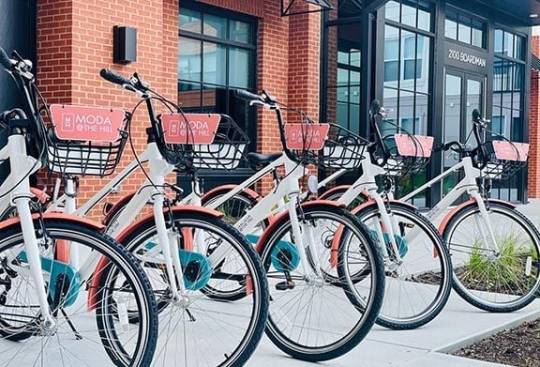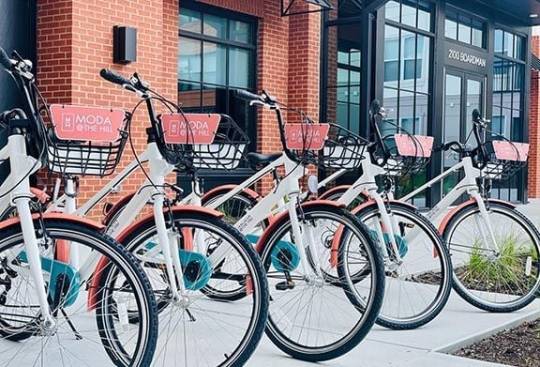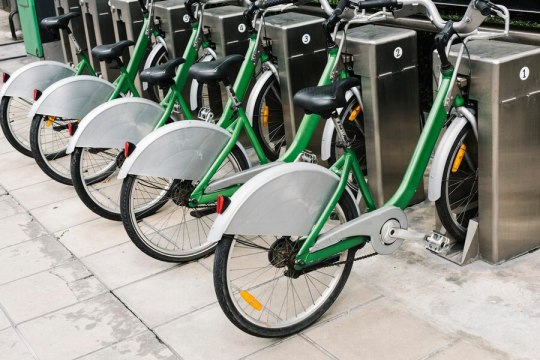#bike share
Explore tagged Tumblr posts
Text

Bathurst Station, Toronto, 2020
#Bathurst#Bathurst station#TTC#transit#bus#busses#transit bus#toronto#toronto streets#street photography#streetscape#city#bike share#urban photography
6 notes
·
View notes
Text
Coffeeneuring 2024, Ride 1: SimWorks special edition at Lower Macleay Park, plus PDX Film League photo walk! Sat 5 Oct
5 Oct 2024. Canon Canonet QL17 G-III/Ilford XP2 I have a tendency to desire my first ride of the annual Coffeeneuring Challenge to start off with a bang, something extra. Sometimes it’s length, like in 2015 with a 60 mile round trip to Warrior Rock Lighthouse. Sometimes it’s “how can I tie it into rock music” like with last year’s debut. Sometimes I’ll do it at the beach, like in 2020. This…

View On WordPress
#bike share#biketown#coffee#coffee outside#lower macleay park#pdx film league#pdxcoffeeoutside#photo walk#seattle film club#simworks
0 notes
Text
Share Bike: Revolutionizing Urban Transportation
https://www.evernote.com/shard/s419/res/0a8ae654-3ab0-74ec-c73f-3df6b944d0e9
Share bikes have emerged as a revolutionary concept in urban transportation, providing a cost-effective and environmentally friendly mode of travel. In this blog, we delve into the world of share bike, focusing on two key aspects: Cycle University and Bike Share Connect. These elements not only enhance the efficiency of bike sharing but also contribute to sustainable urban development.
Benefits of Share Bikes
Cost-Effective Transportation
Share bikes offer an affordable alternative to traditional commuting methods. With flexible pricing options and no fuel expenses, users can save significantly on transportation costs.
Environmentally Friendly
By opting for share bikes, individuals reduce their carbon footprint and contribute to a cleaner environment. This mode of transportation aligns with sustainability goals, making cities greener and healthier.
Health Benefits
Cycling promotes physical activity and improves overall fitness. Share bike encourage people to incorporate exercise into their daily routines, leading to a healthier population.
Cycle University: What It Offers
Cycle University serves as a hub for cycling enthusiasts, offering a range of courses and programs designed to enhance biking skills. From beginner workshops to advanced training, participants gain knowledge and confidence in cycling.
The university provides access to state-of-the-art facilities and resources, including specialized bikes, maintenance workshops, and safety gear. This comprehensive approach ensures that cyclists are well-equipped for their journeys.
Bike Share Connect: Enhancing Bike Sharing
Bike Share Connect integrates technology into bike sharing, streamlining the user experience. Through mobile apps and smart stations, users can easily locate, unlock, and ride share bikes, making transportation more accessible and convenient.
The platform's expansion initiatives aim to reach underserved communities, promoting inclusivity in urban mobility. By leveraging data analytics, Bike Share Connect optimizes bike distribution and enhances system efficiency.
How Cycle University and Bike Share Connect Collaborate
Cycle University and Bike Share Connect collaborate to promote sustainable transportation and educational initiatives. Through joint programs and partnerships, they raise awareness about the benefits of biking and advocate for cycling-friendly infrastructure.
By integrating academic insights with practical solutions, this collaboration drives innovation in urban mobility and fosters a culture of cycling among diverse populations.
Case Studies: Successful Implementation
Several cities have successfully implemented share bike programs, showcasing the impact of these initiatives. Case studies highlight increased bike usage, reduced traffic congestion, and positive community feedback.
By studying these success stories, urban planners and policymakers can learn valuable lessons and replicate effective strategies in their cities.
Challenges Faced by Share Bike Programs
Despite their benefits, share bike programs face challenges such as maintenance issues and user education. Ensuring bike availability, addressing technical issues promptly, and educating users on safe riding practices are key priorities for program sustainability.
Future Prospects and Innovations
The future of share bikes holds exciting prospects, with ongoing innovations in bike design, technology integration, and urban planning. Collaborative efforts between public and private sectors are driving advancements in bike sharing, making cities more bike-friendly and accessible.
As technology evolves, share bikes will continue to evolve, offering enhanced features, improved connectivity, and seamless user experiences.
Conclusion
Share bikes, including Cycle University and Bike Share Connect, play a vital role in transforming urban transportation. By promoting sustainability, fostering community engagement, and addressing mobility challenges, these initiatives contribute to creating vibrant, livable cities.
Embracing shared bikes not only benefits individuals but also leads to a more sustainable and resilient urban environment.
FAQs (Frequently Asked Questions)
1. What are the primary benefits of using share bikes?
Share bikes offer cost-effective transportation, promote environmental sustainability, and contribute to improved health through physical activity.
2. How does Cycle University enhance the biking experience?
Cycle University provides training, resources, and specialized programs to enhance biking skills and promote a cycling culture.
3. What role does technology play in Bike Share Connect?
Bike Share Connect utilizes technology to streamline bike sharing, improve accessibility, and optimize system efficiency.
4. What challenges do share-bike programs face?
Share bike programs face challenges such as maintenance issues, user education, and infrastructure development.
5. What does the future hold for share bikes?
The future of shared bikes includes ongoing innovations, collaborative partnerships, and enhanced user experiences, contributing to sustainable urban mobility.
0 notes
Text
Transforming City Transportation: The Impact of Bike Sharing

In recent years, bike share programs have emerged as a popular and eco-friendly mode of transportation in urban areas. These programs offer a convenient and affordable way for people to navigate cities while reducing their carbon footprint. This blog explores the concept of bike share, its benefits, challenges, and the future it holds.
What is Bike Share?
Bike share, also known as bike rental or bike-sharing, refers to a system where bicycles are made available for shared use to individuals on a short-term basis. These bikes are typically stationed at designated docking stations located throughout a city.
Benefits of Bike Share
One of the primary advantages of bike share programs is the promotion of physical activity. Cycling is a low-impact exercise that helps improve cardiovascular health and overall fitness levels.
Environmental Benefits
Bike share plays a crucial role in reducing greenhouse gas emissions and air pollution. By encouraging cycling over driving, it contributes to cleaner and healthier urban environments.
Cost Savings
Using bike share can lead to significant cost savings for individuals compared to owning a car or using other forms of transportation. It eliminates expenses related to fuel, parking, and vehicle maintenance.
Bike Share Programs
Bike Share University
Bike share programs within university settings not only benefit individuals but also contribute to broader urban mobility strategies. They alleviate parking congestion, reduce carbon emissions, and promote a healthier lifestyle among students and staff. Additionally, these programs often include educational components, promoting bike safety and awareness among users. As cities continue to prioritize sustainable transportation solutions, partnerships between bike university and hotel bikes providers play a vital role in creating more bike-friendly environments and fostering a culture of active commuting within academic communities.
Bike Share Infrastructure
The success of bike share relies on well-planned infrastructure, including bike lanes, dedicated parking areas, and maintenance stations. Cities with robust bike share infrastructure often see higher usage rates and user satisfaction.
How Bike Share Works
Users typically sign up for a bike share program either through a mobile app or at a kiosk located near the docking stations. They can then unlock a bike, ride it to their destination, and return it to any available docking station.
Bike sharing has emerged as a transformative force in city transportation, revolutionizing the way people commute, reducing carbon footprints, and promoting healthier lifestyles. This innovative concept has gained immense popularity in urban areas worldwide, including major cities like Chicago, due to its numerous benefits and positive impact on communities.
The introduction of bike-sharing programs has significantly transformed city transportation dynamics. These programs provide convenient access to bicycles at various docking stations across the city, allowing commuters to rent and return bikes at their convenience. This accessibility has encouraged more people to choose biking as a viable mode of transportation, reducing reliance on cars and alleviating traffic congestion in urban areas.
One of the key impacts of bike sharing is its contribution to sustainability and environmental conservation. By promoting cycling as a sustainable transportation option, cities like Chicago have witnessed a reduction in greenhouse gas emissions and air pollution levels. This shift towards eco-friendly transportation aligns with global efforts to combat climate change and create greener, healthier cities.
Moreover, bike sharing has promoted active living and improved public health outcomes. Regular cycling not only reduces the risk of chronic diseases like obesity and cardiovascular issues but also enhances overall well-being and mental health. Cities that prioritize bike-sharing programs experience a surge in community engagement, as residents embrace outdoor activities and explore their surroundings in a more sustainable manner.
The economic impact of bike sharing cannot be overlooked. These programs stimulate local economies by creating jobs in bike maintenance, station operations, and customer service roles. Additionally, increased bike usage contributes to reduced wear and tear on roads and infrastructure, leading to potential cost savings for city maintenance budgets.
In terms of social impact, bike sharing fosters inclusivity and accessibility in transportation. It provides an affordable and convenient option for individuals from diverse socio-economic backgrounds to navigate the city efficiently. Furthermore, bike-sharing initiatives often integrate with public transit systems, offering seamless multi-modal transportation solutions for commuters.
The success of bike sharing lies in its ability to address multiple urban challenges simultaneously. By promoting sustainable transportation, improving public health, boosting local economies, and fostering social inclusion, bike-sharing programs have become integral components of modern city planning and development strategies.
Challenges and Solutions
Safety Concerns
One challenge facing bike share programs is ensuring the safety of cyclists on busy streets. Cities address this issue by implementing bike lanes, traffic signals for cyclists, and educational campaigns on safe riding practices.
Maintenance Issues
Maintaining a fleet of shared bikes requires regular upkeep and repairs. Bike share operators work closely with maintenance teams to ensure that bikes are in optimal condition for users.
Accessibility Challenges
Some communities may face barriers to accessing bike sharing, such as limited docking stations in certain neighborhoods. To address this, cities are expanding their bike share networks and offering subsidies for low-income users.
Future of Bike Share
Technological Advancements
The future of bike share is shaped by technological innovations such as electric bikes, GPS tracking systems, and mobile payment options. These advancements enhance user experience and encourage broader adoption of bike share.
Conclusion
In conclusion, bike share programs offer a sustainable and efficient solution to urban mobility challenges. They promote health and wellness, reduce environmental impact, and contribute to vibrant, bike-friendly cities. The impact of bike sharing on city transportation is profound and multifaceted. It represents a paradigm shift towards sustainable, healthy, and inclusive urban mobility solutions. As cities continue to prioritize cycling infrastructure and expand bike-sharing initiatives, the positive ripple effects on the environment, public health, economy, and community well-being will continue to grow, shaping a more vibrant and resilient urban future.
0 notes
Text
University Bike Share Programs: Promoting Sustainable Transportation on Campus

Outline of the Article
Introduction to Bike Share Programs
– Definition and purpose
– Growing popularity
Benefits of Bike Share Programs
– Environmental impact
– Health benefits
– Cost-effectiveness
Overview of University Cycles
– Introduction to university bike share programs
– Advantages for students and faculty
– Case studies or examples
University Cycles: How It Works
– Registration process
– Access points on campus
– Rental duration and fees
Promoting Sustainable Transportation
– University initiatives
– Encouraging bike use among students
– Impact on campus carbon footprint
Advantages of Using University Bicycles
– Convenient transportation option
– Reduction in parking issues
– Promoting a healthy lifestyle on campus
Integration of Technology in Bike Share Programs
– Mobile apps for bike rentals
– GPS tracking and safety features
– User feedback and improvements
Challenges and Solutions
– Maintenance issues
– Vandalism and theft prevention
– Balancing supply and demand
Case Studies of Successful University Bike Share Programs
– Examples from various universities
– Lessons learned and best practices
Future Trends in Bike Share Programs
– Expansion of services
– Integration with public transportation
– Innovations in bike technology
Safety Measures and Guidelines
– Importance of wearing helmets
– Sharing the road with other vehicles
– Tips for safe cycling on campus
Community Engagement and Inclusivity
– Outreach programs for underserved communities
– Promoting diversity in cycling
Economic Impact of Bike Share Programs
– Boosting local businesses
– Savings for students and faculty
– Economic benefits for the university
Environmental Sustainability Initiatives
– Partnering with eco-friendly organizations
– Recycling and waste reduction efforts
Conclusion
– Recap of benefits
– Importance of promoting bike share programs in universities
– Future outlook
Bike share programs have become increasingly popular in urban areas as a sustainable and convenient transportation option. With the rising awareness of environmental issues and the need for eco-friendly alternatives, universities across the globe have embraced bike share initiatives to promote green commuting among students and faculty. This article explores the significance of university bike share program, their benefits, challenges, and prospects.
Introduction to Bike Share Programs
Bike share programs, also known as bike-sharing or cycle hire schemes, are innovative transportation systems that allow individuals to rent bicycles for short-term use. These programs typically operate through self-service bike stations located at various points within a city or campus.
Benefits of Bike Share Programs
The proliferation of bike share programs is attributed to their numerous benefits, including:
– Environmental Impact: By encouraging cycling over motorized transportation, bike share programs help reduce carbon emissions and alleviate traffic congestion.
– Health Benefits: Cycling promotes physical activity, leading to improved cardiovascular health and reduced risk of chronic diseases.
– Cost-Effectiveness: Compared to owning a personal vehicle or using public transportation, bike share programs offer a more economical mode of travel.
Overview of University Cycles
University bike share programs cater specifically to the needs of students, faculty, and staff members on campus. These programs provide an affordable and sustainable alternative to traditional modes of transportation.
University Cycles: How It Works
University bike share programs typically involve the following steps:
Registration Process: Users register for the program either online or through designated kiosks on campus.
Access Points on Campus: Bike stations are strategically located across the university campus for easy access.
Rental Duration and Fees: Users can rent bikes for short periods, usually by the hour or day, with affordable rental fees or subscription plans.
Promoting Sustainable Transportation
University bike share programs play a crucial role in promoting sustainable transportation practices within campus communities.
Advantages of Using University Bicycles
– Convenient Transportation Option: University bicycles offer a convenient mode of travel for students commuting between classes, dormitories, and other campus facilities.
– Reduction in Parking Issues: By encouraging cycling, universities can alleviate parking congestion and reduce the need for additional parking infrastructure.
– Promoting a Healthy Lifestyle on Campus: Cycling promotes physical activity and outdoor recreation, contributing to a healthier campus environment.
Integration of Technology in Bike Share Programs
Advancements in technology have enhanced the functionality and accessibility of university bike share programs.
Challenges and Solutions
While university bike share programs offer numerous benefits, they also face several challenges, including:
– Maintenance Issues: Ensuring the proper maintenance and upkeep of bicycles and docking stations is essential to the program’s success.
– Vandalism and Theft Prevention: Implementing security measures, such as surveillance cameras and secure locking mechanisms, helps deter vandalism and theft.
– Balancing Supply and Demand: University bike share programs must effectively manage bike distribution and availability to meet user demand across campus.
Case Studies of Successful University Bike Share Programs
Several universities have implemented successful bike share programs, serving as models for others to follow.
Future Trends in Bike Share Programs
The future of university bike share programs is promising, with advancements in technology and increasing support for sustainable transportation initiatives.
Safety Measures and Guidelines
Ensuring the safety of cyclists is paramount in university bike share programs. Users should adhere to safety guidelines, including wearing helmets and obeying traffic laws.
Community Engagement and Inclusivity
University bike share programs should strive to engage diverse communities and promote inclusivity among users.
Economic Impact of Bike Share Programs
In addition to their environmental and health benefits, university bike share programs contribute to the local economy by supporting small businesses and reducing transportation costs for students and faculty.
Environmental Sustainability Initiatives
Many universities are actively involved in environmental sustainability initiatives, including bike share programs, as part of their commitment to reducing carbon emissions and promoting eco-friendly practices.
Conclusion
University bike share programs play a vital role in promoting sustainable transportation solutions on campus. By providing affordable, convenient, and eco-friendly transportation options, these programs contribute to a healthier and more environmentally conscious campus community. With continued support and investment, university bike share programs have the potential to revolutionize the way students and faculty commute within campus environments.
Unique FAQs
Are university bike share programs free for students?
– While some universities offer free bike share programs, others may charge nominal rental fees or subscription fees.
How can universities ensure the safety of cyclists using bike share programs?
– Universities can implement safety measures such as providing helmets, promoting safe cycling practices, and maintaining well-lit bike paths on campus.
What steps can universities take to address maintenance issues in bike share programs?
– Universities can establish regular maintenance schedules, invest in durable equipment, and train staff members to perform timely repairs.
Do university bike share programs accommodate individuals with disabilities?
– Universities should strive to make bike share programs accessible to individuals with disabilities by offering adaptive bicycles and inclusive infrastructure.
How can students contribute to the success of university bike share programs?
– Students can support bike share programs by using them regularly, providing feedback for improvements, and advocating for sustainable transportation initiatives on campus.
0 notes
Text

Rolling Away: A Writer Says Farewell to Shared Micromobility
0 notes
Text
Pertinent news updates suppressed by the establishment and much more! Shared daily!!! Watch my show #SupplementalBroadcast 🎱#youtuberecommendedchronicles🔮 on YouTube & Rumble New episodes posted regularly!!! 🧩🙏🎟️ #NewsUpdates #3DMatrix #conspiracy #currentevents #5DEarth #TheGreatAwakening
0 notes
Text
Revolutionizing Urban Mobility: The Rise of Bikeshare Companies and Connected Bike Sharing
In the bustling landscapes of urban cities, where traffic jams and pollution have become daily challenges, a new wave of transportation has emerged, transforming the way people navigate their surroundings. Bikeshare companies have swiftly taken center stage, offering a convenient, eco-friendly solution—shared bikes, promoting accessibility and sustainability in urban mobility.

The Evolution of Bikeshare Companies
Bikeshare companies have revolutionized commuting by providing shared bicycles, accessible through various docking stations spread strategically across cities. These companies operate on a simple premise: rent a bike for a short period and return it to any designated docking station.
The beauty of these systems lies in their simplicity and accessibility. Users can sign up via mobile apps or kiosks, unlocking bikes using codes or RFID cards. With an array of subscription options and payment models, bikeshare companies cater to diverse user needs, from tourists exploring a city to daily commuters opting for a greener mode of transport.
Shared Bikes: Redefining Urban Mobility
Shared bikes have swiftly become a symbol of urban transformation. These bikes, available for short-term use, contribute significantly to reducing traffic congestion and carbon emissions. The convenience of picking up and dropping off bikes at designated stations has made them a popular choice for both locals and tourists alike.
What sets shared bikes apart is their versatility. They offer a flexible solution for the "last mile" problem, seamlessly integrating with existing transportation networks. Commuters can combine bike rides with public transport, optimizing their travel time and reducing dependency on private vehicles.
Bike Share Connectivity: Bridging Cities and Communities
One of the pivotal aspects shaping the success of bikeshare systems is their connectivity. The ability to seamlessly connect users with bikes across a city is a game-changer. Bike share connect relies heavily on technology—smartphone apps, GPS, and IoT devices—to ensure users can easily locate, unlock, and return bikes at any station within the network.
Innovations in bike share connectivity have propelled the industry forward. Integrated systems allow users to track bike availability, plan routes, and even pay for rides through user-friendly interfaces. This connectivity not only enhances user experience but also enables bikeshare companies to optimize bike distribution, ensuring bikes are available where and when they are needed most.
The Impact and Future of Bikeshare Companies
The impact of bikeshare companies transcends mere convenience. They promote healthier lifestyles, reduce carbon footprints, and foster a sense of community engagement. Cities worldwide are increasingly investing in bike-friendly infrastructure, further amplifying the reach and success of these systems.
Looking ahead, the future of bikeshare companies seems promising. Advancements in technology will continue to refine user experiences, making bike sharing more seamless and accessible. Collaborations between bikeshare companies and city planners will further integrate shared bikes into urban transportation frameworks, making cities more livable and sustainable.
Conclusion
Bikeshare companies and shared bikes are not merely modes of transportation; they are catalysts for change in urban mobility. The amalgamation of technology, accessibility, and sustainability has made these systems indispensable in today's cities. As connectivity and innovation continue to drive this industry forward, bikeshare companies will undoubtedly play a pivotal role in shaping the future of urban transportation.
In essence, the shared vision of bikeshare companies—providing a convenient, eco-friendly, and interconnected mode of transport—is steering urban mobility towards a brighter, more sustainable future.
Remember, the wheels of progress are always turning, and bikeshare companies are at the forefront, pedaling us towards a more connected and greener world.
0 notes
Text

0 notes
Text






Destination: your heart Estimated Time of Arrival: whenever you need him ➤ for @jung-koook ♡
#btsgif#dailybts#bts#bangtan#bstedit#usergif#jeon jungkook#usersky#userkelli#userpat#usermaggie#tuserandi#userdimple#raplineuser#useremmeline#usersan#*jk#*gifs#*gfx#*comp#happy happy birthday dear sky! I hope you have the best day!!!!#thank you for being such a pillar of this fandom and always being so geneours with sharing both your gifs and also content#you're a saint and we don't deserve you!!!#may this new year of your life bring you lots of happiness relaxation success and great new memories#the idea for this little gift here came to me through your excitement of him driving The Big Bikes haha#and you were also so endeared by his skipping#so here's a compilation of some of his more entertaining chapter 2 modes of transport!#it's really silly and there're way too many colours for my taste lmao but I hope it at least makes you smile!!!#and sorry for the quality it somehow really suffered :(#I love you sky!!!!
1K notes
·
View notes
Text

remember that work in progress i shared?
its complete now, also i changed the harley bike for a ducati cuz i think that would make more sense for jason to have
#jason todd and his cool bike cuz he's cool and yeah cool but my art makes him pink kind of instead of red but hes still cool i like to think#the quality is absolutely destroying the noise filter i had but im not reuploading it#i swear if this gets less notes than the work in progress sketch i shared a month ago im gonna go insane#batfam#digital art#my art#dc#jason todd#my fanart#dc red hood#jason todd fanart#jason todd red hood#dc jason todd#batman comics#digital aritst#digital illustration#im out of tagsssssssss
3K notes
·
View notes
Text

Would you let me work on your bike? :)
#wife#hot wife#sexy wives#wife exhibition#hotwives#sharing wife#swinger#naughty wives#wifeshare#mtb#mountain bike#mountain bike babe
903 notes
·
View notes
